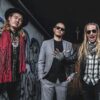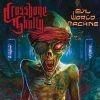We Tune You Up
Listeners:
Top listeners:
00:00
00:00
chevron_left
-
 play_arrow
play_arrow
WTYU.rocks We Tune You Up
The Faces: The Band That Lit My Musical Fire
Chris Herninko
Bassist, The Circus Hearts
I can’t tell you how many times I’ve had this conversation about my favorite band. It usually starts with someone (neighbor, family member, etc.) asking me how my band is doing. The usual follow-up question is, “What do you guys sound like?” So I start to list our musical influences: The Rolling Stones, Sam Cooke, The Black Crowes, The Faces…
Cue the blank stare.
“Who are The Faces? Never heard of them.”
Ugh! Here we go again. Yes, you absolutely know The Faces; you just don’t know that you know them.
Me: “Rod Stewart’s band.”
Them: “Oh yeah, I love Rod Stewart.”
Me: “He was in a band.”
Them: “He was?”
YES! And NOBODY had more fun doing what they were doing than The Faces. NOBODY! The Black Crowes put a bar on the stage during their last tour? That’s cute. The Faces did that in 1972. Joe Walsh liked to throw TVs out of hotel windows? Umm…Ronnie Wood invented it!
“Heard you were in town, great. Let’s go wreck a room.”

Stood on the Table with My Glass of Gin…
The Faces were five “East End Tarts” who were acutely fond of their wine, women and song (Possibly in that order). Rod Stewart, Ronnie Wood, Ronnie Lane, Ian McLagan and Kenny Jones. They formed in 1969 from the ashes of The Small Faces and The Jeff Beck Group. They were originally going to call their new project “Blind Drunk” but the contractual obligations to their management at the time forced them to keep half of the name that made three-fifths of them famous. They decided to drop the “Small” because Stewart and Wood standing at 5’ 9” were decided taller than the other three members of the band. They weren’t so small anymore. They were to be The Faces. (Although they were originally billed as The Small Faces, especially in the U.S. where the previous incarnation had a considerable following). Let the good times begin. This is going to be one hell of a ride. Short-lived, but packed with enough fun to last a lifetime.
“We spend more money in the boozer than we do in the studio.”
– Kenny Jones

Good Boys…When They’re Asleep
The Faces were just different, for better or for worse. In 1969, The Beatles were no longer playing live and getting very experimental in the studio, The Rolling Stones were still a Blues/Pop band dealing with the loss of their founding member Brian Jones. Led Zeppelin was still in their infancy and The Who was shedding their “Mod” skin and recording a Rock Opera. With two main songwriters (Stewart and Lane) The Faces moved seamlessly from pure Rock ‘n’ Roll to folksy Soul music. They could be sloppy and all over the place on one song and brilliantly heartfelt on the next. You just never knew what you were going to get. It was glorious. They also had one of the greatest singers in the history of Rock ‘n’ Roll.
Their “devil-may-care” attitude was apparent in the studio and carried over to the stage. They were known for spending more time in the pub than in the actual studio. “We’d indulge in a few drinks at the pub, record a song, and then go back to the pub.” Their live sets were notorious for being raucous events with undeniable energy. They also might have been the most stylish band of the day. Roderick and Ronnie invented the Peacock feather hairstyle. They sported leopard suits, platform shoes, scarves, hats, silk, satin, tweed, and tartan pants before anyone else. Again, you never knew what you were going to get.
“Jagger might think he got into satin jackets first, but he didn’t.”
– Nick Logan

It Was Love at First Listen for Me
Around 1991, I was in a band struggling to find its identity. We were young, and ’80s hair bands had been our teenage soundtrack. But we weren’t great at the “hair band” thing, and by 1990, the genre was getting stale. We leaned more toward the Rock ’n’ Roll side than the metal side. After going through guitar players at an alarming rate, we were lost. We fell in love with The Black Crowes and The Electric Angels but didn’t know where that sound came from.
Enter John Magrorty, our fifth guitarist in three years. John, a few years older, saw where we wanted to go and knew where we needed to start. Instead of plugging in at rehearsals, we listened. He brought stacks of cassettes, turning us on to bands like The Small Faces, Free, Humble Pie, The Jeff Beck Group, T. Rex, and The Faces.
I still love all those bands, but The Faces really stuck with me. They were loose, sloppy, fun—they were mine. It was love at first listen.
“Anything I say is not meant to be a blot on anyone’s character…or trousers.”
– Rod Stewart

Had Me a Real Good Time…at “The Wick”
They were the life of the party. They were the first ones to show up and the last to leave. They were the center of the London scene. Don’t believe me? Do some research about Ronnie Wood’s home in Richmond called “The Wick”. Oh the stories those walls could tell. Everyone was there. Keef, Townsend, Elton, Bowie, Jagger, Bolan. It was the nucleus of what was happening across the pond in 1971. And the Faces were smack dab in the middle of it.
Yeah, they may have faded faster than those other bands, but they left a trail of spilt drinks, hangovers, mischief, and decadence to last forever.
From “First Step” to “Long Player” to “A Nod” to “Ooh La La” they blazed through four albums in five years. There were high-energy rockers like “Had Me a Real Good Time,” “Miss Judy’s Farm,” “Stay With Me,” “Too Bad” and “Borstal Boys.” There were soulful ballads like “Devotion,” “Sweet Lady Mary,” “Debris,” “Love Lives Here” and “If I’m on the Late Side.” There were also folksy and mid-tempo ditties like “Stone,” “Plynth,” “Last Orders Please,” “Glad and Sorry,” “Bad and Ruin” and “Cindy Incidentally.” Each was coherently different yet utterly Faces. It was a style that was theirs, and it was unduplicatable.
“Overgrown adolescent ruffians riffing away through a fog of booze, bed-hopping, and fisticuffs.”
– Record Collector

Rod’s Solo Career Killed the Faces? Bullocks!
This is a very popular misconception. Rod Stewart’s stardom after “Every Picture Tells A Story” certainly put a strain on the band, but Rod already had a solo career when he joined the Faces. His solo career (with a different label) ran simultaneously with his Faces career without as much as a second thought. Then in 1971 some DJ in Cleveland decided to flip over the single for “Reason to Believe” and play the B side (Maggy May) ! As you know the song exploded and catapulted Rod into the stratosphere. Which is kind of funny because it almost didn’t make the record. It’s time signature was a dull 4/4 beat and it literally didn’t have a chorus.
But I digress. The Faces had always incorporated Rod’s solo songs into their live set, but now it was mandatory. It’s what the crowds wanted to hear. However, later that same year, the Faces recorded their own album (A Nod is as Good as a Wink….to a Blind Horse) which received rave reviews and is probably their best work. “Stay With Me” was their highest-charting song ever. It reached #6 on the U.K. charts and #17 on the U.S. Billboard Hot 100. So 1971 was a great year for everyone involved. They still toured as The Faces, although some booking agents started to bill them as Rod Stewart and the Faces, but the venues got bigger and they were all sold out. Heading into 1972 all parties involved were thriving and everything was good.
The tensions started in 1972 during studio sessions for “Ooh La La.” Ronnie Lane took more of a lead role in the production. Stewart wasn’t convinced it was a good enough follow-up to “A Nod.” Also, the arrangement and production style between the Faces and Stewart’s solo albums were night and day. Faces sessions tended to be loose affairs with scant attention to detail, whereas Stewart’s solo sessions seemed to be detail-oriented with smart song compositions. In Andy Neil’s book Had Me a Real Good Time, it was really Lane who was growing weary of becoming Rod’s backing band (Steve Marriott all over again, he said) and it was Lane who ultimately quit the band. Rod loved being in the Faces. He knew his solo career was a strain on the fellas, but he never quit. By 1975, The Faces had run their course. It was pretty much time for everyone involved to move on to something new. Wood inevitably to the Stones, Jones to the Who, Rod as a solo artist, McLagan as a hired gun, and Lane’s Slim Chance.
The party was over.
But man it was fun!
“Faces will be remembered as not merely a genuinely great band but as “the band” that in the early 70’s saved Rock N Roll from becoming a highly secular brand of pop music dominated by poeticising simps.”
– L.A. Times
Chris Herninko is a bass player, bandleader, and passionate music historian whose band, The Circus Hearts, draws heavy influence from The Faces. Chris brings his deep knowledge, love for classic rock, and personal touch to Tune Up Magazine, connecting readers with the spirit and legacy of the music he cherishes.
Written by: Tune Up Webmaster
70s Rock British Rock Bands Chris Herninko classic rock Influential Rock Bands Love Letter to Bands music inspiration Rock Band Influences rock history Rock Music Legends Rod Stewart Ronnie Wood The Circus Hearts The Faces Tune Up Magazine
Rate it
Similar posts
Recent Posts
- Blended Brew Continue Their Winning Ways With “Roll The Dice”
- Armored Saint to Celebrate 40th Anniversary of Delirious Nomad
- Kirk Hammett to Join Mark Agnesi of Gibson for An Intimate Live Discussion Spanning His Music Career and New Book
- The Fixx Was In
- Kickin Valentina’s Raw Trax Serves Up Killer Cuts & Live Heat
Recent Comments
No comments to show.Featured post
Latest posts

Blended Brew Continue Their Winning Ways With “Roll The Dice”

Armored Saint to Celebrate 40th Anniversary of Delirious Nomad

Kirk Hammett to Join Mark Agnesi of Gibson for An Intimate Live Discussion Spanning His Music Career and New Book

The Fixx Was In

Kickin Valentina’s Raw Trax Serves Up Killer Cuts & Live Heat
Current show

Metal For Breakfast
Hosted by Knuckles
"Metal for Breakfast" is a hard-hitting morning show that serves up heavy riffs and epic anthems to kickstart the day. Fueled by classic and contemporary metal tracks, this show wakes up listeners with a sonic blast that goes well beyond the usual coffee routine. Each episode brings a mix of legendary metal tunes and hidden gems, making it the perfect morning ritual for those who want to start their day on a high-voltage note. Grab your air guitar, turn up the volume, and get ready to rock your way into the day with "Metal for Breakfast."
closeUpcoming shows

Midday with KK
Hosted by KK Law
10:00 am - 2:00 pm
Flashback Café
Hosted by KK Law
12:00 pm - 1:00 pm
WTYU Afternoons
2:00 pm - 7:00 pm

Pete Fry’s Happy Hour
Hosted by Pete Fry
11:00 pm - 12:00 am
The Midnight Snack
Hosted by Mr. X
12:00 am - 1:00 amChart
Tune Up Magazine LISTEN TO WTYU NOW













Post comments (0)